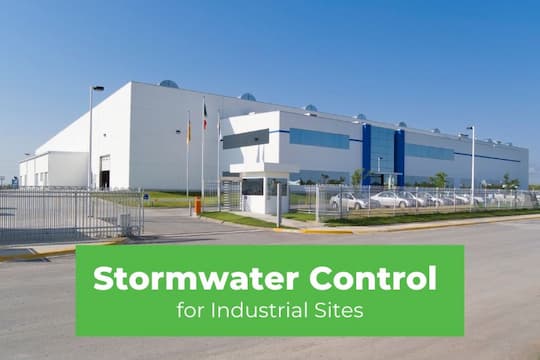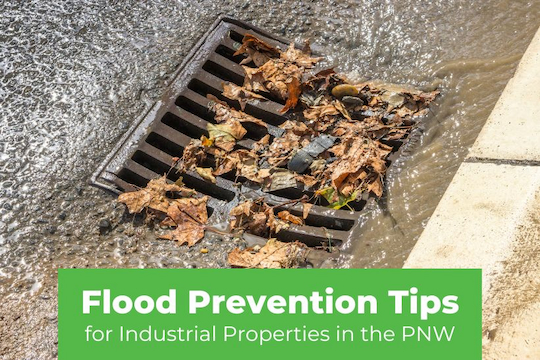Effectively managing stormwater is essential for property owners and managers to prevent issues like flooding, erosion, and even health risks. Here are some of the most common stormwater challenges, along with actionable solutions to address them.
Blocked Drainage Basins
Challenge:

Stormwater systems depend on the free flow of runoff into drainage basins. When these basins become clogged or blocked, the flow is disrupted, causing pooling and structural risks. Organic debris like leaves, branches, and trash are some of the most common causes of blockages, especially when basins become inadvertently covered or obstructed by landscaping. Roots from nearby trees can also infiltrate pipes and basins over time, causing significant damage. Additionally, sediment from runoff can accumulate, decreasing drainage capacity.
Unmanaged blockages can escalate quickly, leading to property flooding, soil erosion, and standing water that attracts mosquitoes—posing a health risk in some areas.
Solution:
Routine maintenance is essential for keeping drainage basins functioning efficiently. Regular cleaning to remove debris from basins, entry points, and pipes helps prevent clogs. Hiring a professional service ensures that both surface and structural issues are addressed. To minimize the impact of roots, root barriers can be installed around drainage systems to block tree roots from reaching the pipes without harming the trees. For additional flood prevention tips, consider proactive measures to keep basins clear year-round.
Bioswale Efficiency

Challenge:
Bioswales, which filter and absorb stormwater, can lose efficiency if not maintained. Leaves and trash can clog bioswales, leading to pooling and reducing the bioswale’s ability to control water flow. Proper vegetation is crucial for bioswales to function correctly, and non-native plant species often invade these areas. These invasive plant species crowd out intended vegetation and compromise water filtration and pollutant removal.
Invasive plants disrupt the ecosystem by eventually replacing native species that are better suited to support water absorption and filtration. The imbalance results in reduced efficiency, which could lead to increased flooding.
Solution:
Regular inspections and maintenance of bioswales are vital to ensure they operate at peak efficiency. Clearing out debris and ensuring smooth water flow is critical for preventing clogs and pooling. Removing invasive species and replacing them with native plants helps maintain an optimal bioswale environment, as native plants often require less water and adapt well to local conditions. Regularly monitoring the health of vegetation allows property managers to address plant health issues quickly, helping the bioswale function as intended.
Rain Gardens with Compacted Soil

Challenge:
Rain gardens are valued for both their aesthetic appeal and stormwater management benefits. However, they are vulnerable to soil compaction, which prevents proper drainage and can lead to waterlogged, dying plants. Compacted soil reduces the garden’s capacity to absorb stormwater, causing runoff to increase and overflow the area.
Erosion is also a common issue in rain gardens, often due to compacted soil from foot traffic or the death of plants that would otherwise hold the soil in place. People walking across the garden may inadvertently damage plants, creating bare patches that contribute to erosion and compromise the rain garden’s ability to manage stormwater.
Solution:
Improving the soil’s drainage is a key strategy. Replacing compacted soil with sand, compost, and topsoil can enhance permeability, allowing water to drain more effectively. Planting native species with deep roots helps stabilize the soil, reducing erosion and improving resilience against foot traffic. Installing a footpath or adding low fencing around the rain garden can discourage unintended foot traffic, preserving the garden’s natural structure. Educating residents and visitors about protecting the rain garden also helps maintain its functionality.
Stormwater System Maintenance

Challenge:
Routine maintenance is critical to keeping a stormwater system functional. However, this aspect of property management is often overlooked, especially when issues are not immediately visible. Over time, sediment, leaves, and other debris accumulate in storm drains, pipes, and catch basins, restricting water flow and reducing system capacity. These issues can become particularly problematic during seasonal changes, such as autumn, when falling leaves can clog drains, or spring, when winter runoff sediment may decrease drainage efficiency.
Without preventative maintenance, a stormwater system may eventually reach a point where its capacity is severely compromised, increasing the risk of flooding and damage.
Solution:
Preventive maintenance is key to long-term stormwater management. Scheduling regular inspections and cleanouts, especially after major storms or at the beginning of each season, keeps the system at full capacity. Removing sediment from detention basins ensures they maintain their designed storage capacity. Additionally, regular vegetation management around basins, such as trimming, weeding, and replanting, helps prevent surrounding plants from contributing to clogs.
For added assurance, partnering with professional stormwater management experts, like CatchAll Environmental, provides access to specialized tools and expertise for maintaining stormwater systems. Their services help address surface and below-ground maintenance needs, ensuring the system remains functional and reducing the risk of unexpected clogs or structural damage.
Take Action to Improve Stormwater Management
Proactive stormwater management is essential for property owners who aim to maintain their properties' functionality and aesthetics. Regularly maintaining drainage basins, bioswales, rain gardens, and the overall stormwater system minimizes the impact of stormwater issues. Partnering with an experienced storm drain cleaning service near you, like CatchAll Environmental, ensures your property remains prepared for any weather conditions.
Contact CatchAll Environmental today to learn more about our comprehensive stormwater management services and discover how we can help you with a customized maintenance plan tailored to your needs.













